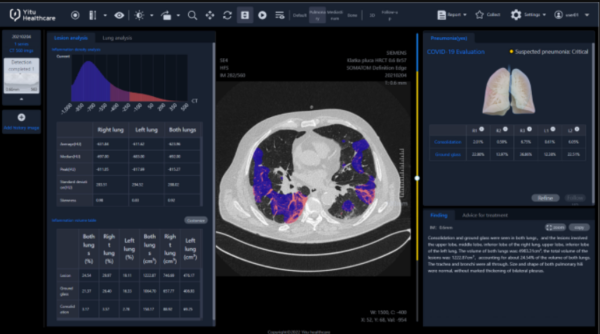Lung ultrasonography in COVID-19 pneumonia, validated by high-resolution computed tomography and artificial intelligence 2023

In clinical practice, lung ultrasonography (LUS) is an increasingly used imaging technique. During the COVID-19 pandemic, its portability and simplicity of use compared to high-resolution computed tomography elevated its significance (HRCT). The purpose of this study was to evaluate the efficacy of LUS in assessing the degree of lung involvement and differentiating lesion types in the course of COVID-19 pneumonia to that of HRCT processed using artificial intelligence (AI).

Methods
This was a prospective observational study of hospitalized adults with COVID-19 who underwent first HRCT and LUS within 72 hours of each other. AI completed HRCT evaluation automatically. We analyzed the connections between the inflammation volume measured by both LUS and HRCT, between LUS findings and the HRCT structure of inflammation, and between LUS and inflammatory laboratory indicators. In addition, we examined the LUS outcomes in subgroups based on the duration of respiratory failure during hospitalization.

Results
The median age of study participants was 63 years old. The median LUS score was 19 (IQR—interquartile range 11–24) while the median CT score was 22 for both lungs (IQR 16–26). There were strong relationships between LUS and CT scores (r = 0.75 for both lungs) and between LUS and percentage inflammatory volume (PIV) (r = 0.69).
While weaker, the relationships remained substantial for individual lung lobes. The relationships between the LUS score and the value of the percentage consolidation volume (PCV) divided by the percentage ground glass volume (PGV) were either weak or not statistically significant. There was a significant relationship between the LUS score and C-reactive protein (r = 0.55) and between the LUS score and interleukin 6 (r = 0.39). Much higher LUS scores were seen in subgroups with more severe respiratory failure.
Conclusions
LUS is a reliable approach for determining the extent of COVID-19 pneumonia and a potential tool for estimating its clinical severity. Assessment of LUS in determining the structure of inflammation necessitates more research throughout the disease’s progression.
